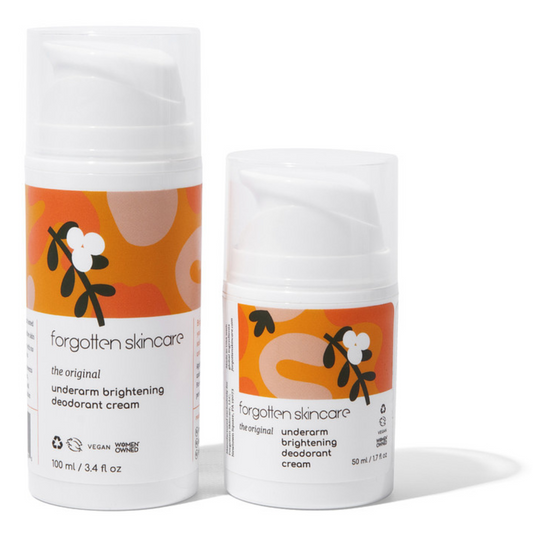Deodorants and antiperspirants are two of the most common cosmetics in use. A cosmetic is defined as any product that is applied to the body to improve, modify, or enhance appearance. As with any cosmetic, it isn’t uncommon for users to experience unwanted side effects, the most common being irritated skin caused by contact dermatitis. If you’ve ever experienced a reaction from using a cosmetic that includes red, itchy, bumpy skin that peeled, blistered, or even oozed, you’ve experienced contact dermatitis.
Common sense may say that it must be the chemical content of our deodorant that is causing the skin irritation. So it makes sense to hunt for something more natural, and in the case of deodorants, affected users often search for a generic “natural deodorant.”
But what does the term “natural deodorant” imply? Does the use of the word “natural” indicate “safe and allergy free?” Not so much, as studies show. Before we dive into the research, let’s talk about the difference between deodorant and antiperspirant to get a better understanding of the two.

Deodorants vs. antiperspirants
Deodorants have one major function, which is to mask underarm odor caused by naturally occurring bacteria. A key ingredient in deodorant is anything that has antibacterial properties, which include some essential oils (tea tree oil is one). Deodorants don’t keep you from sweating.
Antiperspirants are different in that they block the natural bodily function of producing underarm sweat. This is achieved by the addition of aluminum, the main ingredient in many antiperspirants. Because antiperspirants block a main bodily function, they are considered an OTC drug by the Food and Drug Administration (FDA).
Aluminum has gotten a bad rap in recent times. One fear is that aluminum causes breast cancer, while another concern is that it is linked to Alzheimer’s Disease. It has never been proven that aluminum causes breast cancer, however a study in which rabbits were injected with high levels of aluminum did result in the subjects developing brain fibers that lead to the onset of Alzheimer’s. And for individuals with sensitive skin, aluminum has been known to cause skin irritation.
To sum it up, deodorants mask odor, and antiperspirants keep you from sweating. If you’re trying to stay away from aluminum, then you’re probably already using a deodorant. If you’ve suffered from skin irritation as a result, you might have gone down the “natural deodorant” route. And it can be frustrating when you write off antiperspirants and try to steer clear of unnatural chemicals only to find that natural deodorants also irritate your skin.
Natural deodorant ingredients
If you’re one of the many people that has tried natural deodorant you might have ended up frustrated. Either they don’t mask body odor or they still irritate your skin. The problem with many natural deodorants is that many of them contain the same common allergens as their non-natural cousins.
In a study published in the Journal of Clinical and Aesthetic Dermatology, researchers analyzed and tested 107 common deodorants and antiperspirants. They found that the most common allergens found in deodorant and antiperspirant are fragrance, propylene glycol (PG), essential oils and biological additives, parabens, vitamin E, and lanolin.
In fact, 90% of the deodorants tested contained fragrance, 47% contained PG, and 10% contained essential oils and biological additives. Ten of the deodorants that were tested did not contain fragrance, but they did contain essential oils and biological additives which are triggers for sensitive skin. Of the 107 deodorants tested, only eight of them were deemed safe for individuals who exhibit sensitivity to fragrances.
The truth is, even natural deodorants contain ingredients that can cause an allergic reaction in your underarms.

Deodorant alternatives
There are only a handful of deodorants available for individuals with sensitive skin. One popular alternative is Crystal Body Deodorant, which claims to create an environment where bacteria can’t survive, thus eliminating odor. However, there is no research to back that statement up.
Another alternative is The Original, which is primarily an underarm brightening cream. We made the cream as an all-in-one solution for your underarm concerns with the addition of ingredients that also help with odor, naturally. Salicylic acid helps remove dead skin cell build up, reducing the amount of food for odor causing bacteria to eat and thrive on. While The Original may not be the natural deodorant solution for everyone's skin type, it has proven to work for many women dealing with multiple common underarm skin concerns, including odor, hyperpigmentation, and irritated bumps from shaving.
The most important thing is to listen to your body and do what works for you. Everyone’s biological makeup and skin sensitivities are different. Just remember, you are all beautiful – inside and out.
Resources
“Antiperspirant and Deodorant Allergy” - The Journal of Clinical and Aesthetic Dermatology (2008)
“Deodorant and Antiperspirant Allergy” - Very Well Health (2019)
“The Effect of Habitual and Experimental Antiperspirant and Deodorant Product Use on the Armpit Microbe” - (2016)








